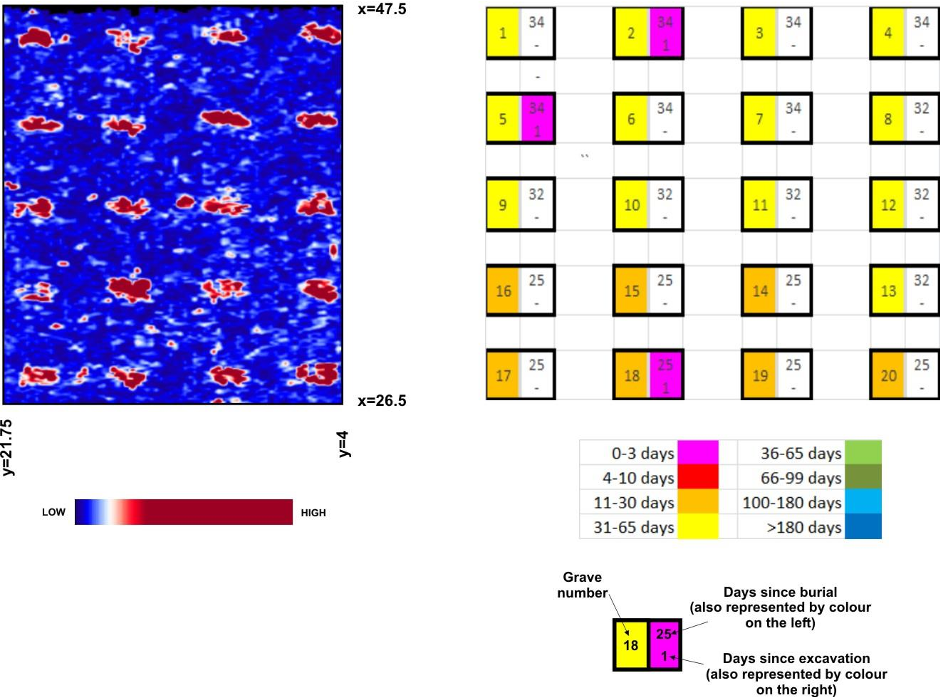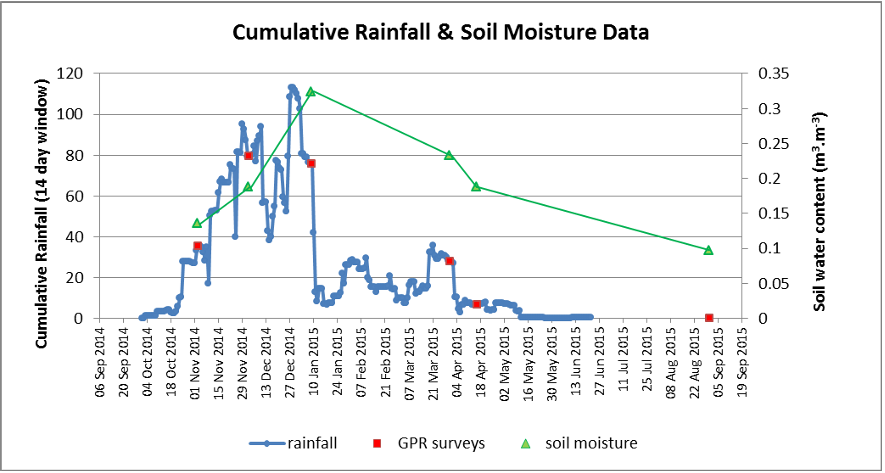
A controlled monitoring study of simulated clandestine graves using 3D
ground penetrating radar
M. van Schoor
1
, W.C. Nienaber
2
and A. Marais-Werner
2
1
Council for Scientific and Industrial Research (CSIR), Pretoria, South Africa
2
University of Pretoria, South Africa
E-mail: mvschoor@csir.co.za
ABSTRACT
A controlled 3D GPR monitoring study over simulated clandestine graves was conducted near Pretoria, South
Africa, in which the detectability of graves as a function of post-burial interval was assessed, as this is of
particular interest to local forensic investigators. It was demonstrated that the site-specific environmental
parameter (a clay-rich loamy soil with poor drainage) and heavy seasonal rainfall (as confirmed by GPR-derived
soil moisture estimates) drastically compromised the long-term grave detectability, especially when adopting a
3D depth slice analyses approach. It is also seen that the disturbed burial zone is the major contributor to the
total grave anomaly rather than the buried body due to the combination of environmental parameters and the
absence of buried artefacts. This paper also advocates the combined use of different data representations (2D
and 3D) to increase the likelihood of detecting subtle grave anomalies.
INTRODUCTION
Ground penetrating radar (GPR) is a widely used and versatile near-surface geophysical method that has been
applied to a diverse range of earth science problems; for example, utility detection, concrete and infrastructure
studies, mining and hydrogeophysics. Although the most common fields of application are still utility detection
and concrete and infrastructure studies (Pers. Comm., Greg Johnston, Sensors & Software Inc., 22 September
2016), the use of GPR is on the rise in the field of forensic geoscience (Schultz, 2012; Pringle et al., 2012).
The popularity of GPR is due to its capability to survey large areas in relatively short times and at a relatively
high (cm-scale) resolution. Barone et al. (2016) also highlighted the onsite real-time processing capability of
modern GPRs as a further key benefit. Most commercially available GPR systems employ a constant-offset
transmitter and receiver antennae configuration that can be mounted on a push-cart. A 3D or grid survey
1

approach is commonly used to cover large areas for the purpose of depth slice extraction and 3D data
visualisation. 3D GPR surveys typically involve a grid of equidistant parallel profiles acquired in two
perpendicular directions to optimise spatial resolution. Data acquisition is usually conducted at a single
operating frequency in the range 100-1000 MHz and the resulting depth of investigation is typically limited to
the first few meters of the near-surface. In GPR there is a trade-off between range and resolution: increasing the
operating frequency implies a higher resolution, but at the cost of a decreasing range associated with the
corresponding increase in attenuation; similarly, a lower operating frequency will enable a greater depth of
investigation, but at a reduced mapping accuracy.
GPR studies that relate to grave detection can be classified as either of a heritage or a forensic nature. In
heritage-related studies the typical survey aim is to identify unmarked cemetery graves; for example, Fiedler et
al. (2009), Hansen et al. (2014) and Barone et al. (2016). Forensic studies typically involve the somewhat more
challenging task of searching for clandestine burials; for example: Pringle et al. (2008) advocated the use of a
multi-technique approach to identify possible clandestine burials in an urban environment and using GPR as a
follow-up tool for obtaining better resolution on selected anomalies; however, the challenges associated with
detecting subtle clandestine burial anomalies using GPR in the noisy and heterogeneous ground conditions of
urban environments were highlighted. Schultz (2008) studied the monitoring of pig cadaver burials in sandy
soils, and emphasised the difficulty of detecting anomalies after a few months because the disturbed zone does
not present as strong a GPR contrast as soils with distinct horizons or higher clay content might. Doolittle and
Bellantoni (2010) focused on the site-specific applicability of GPR in a soil type, which is generally considered
as favourable for GPR due to its low clay content; however, the lack of well-developed soil horizons and the
associated relatively low contrast of the disturbed (burial) zone, as well as the presence of undesirable scattering
bodies such as tree roots, rock fragments, animal burrows and modern cultural debris are described as
challenges. Schultz and Martin (2012) also reflected on the previously mentioned problem of detecting
clandestine burial in sandy environments, particularly when the body is buried without any artefacts or
coverings that may enhance the grave anomaly to some extent. In fact, the difficulty in detecting clandestine
burials is often attributed to the absence of a coffin, container or other artefacts (Pringle et al., 2008; Doolittle
and Bellantoni, 2010; Novo et al., 2011). The covert nature of such burials and the fact that no record exists
imply a greater degree of uncertainty in terms of anticipated location, orientation, age and depth of burial.
Another variable that may adversely affect the GPR detectability of clandestine burials is the soil moisture
2

content, due to the associated increase in bulk soil conductivity (implying a decrease in GPR range). However,
in some cases (depending on the combination of soil type and state of decomposition) an increase in soil
moisture may actually contribute to an enhancement of grave anomalies (Schultz and Martin, 2012; Molina et
al., 2015). It is clearly evident that the detection of clandestine burials using GPR is a challenging problem that
is highly dependent on a range of site-specific, cultural and environmental variables and since forensic
geophysics is also a relatively new application field, there is a definite need for a variety of benchmarking
studies to advance the knowledge in this field.
In South Africa, the applicability of GPR to forensic cases has in recent years attracted the attention of criminal
investigators, with the South African Police Services (SAPS) acquiring several GPR units. However, the
frequency of use for clandestine grave searches is low due to insufficient training and poor technical support of
the investigating officers; for example, during the period January 2015 to July 2016, GPR was only used in three
out of 32 clandestine grave search cases (Pers. Comm. Colonel L Rossouw, SAPS VIC, 25 July 2016; Major W
Ngoma, SAPS Gauteng Crime Scene Management Unit, 26 July 2016). There clearly exists a need to empower
local crime scene investigators in the use of geophysical tools such as GPR and case studies such the one
described in this paper can make a positive contribution in this regard.
Between September 2014 and May 2015, researchers from the Forensic Anthropology Research Centre of the
University of Pretoria (UP) conducted a taphonomic study at a controlled test site. The aim of this study was to
investigate the rate and pattern of decomposition associated with shallow, clandestine burials in the local soil
and environmental conditions. Pig cadavers were used as proxy for human bodies as is commonly done in such
studies (e.g., Schultz, 2008; Molina et al., 2015). Although geophysical monitoring did not originally form part
of the taphonomic research plan, it was decided to run a time-lapse GPR monitoring experiment in parallel with
the taphonomic study and as part of a research collaboration between UP and the Council for Scientific and
Industrial Research (CSIR).
Four 3D GPR surveys were conducted between November 2014 and March 2015 and preliminary results and
findings were reported on in Van Schoor et al. (2015). Two additional 3D GPR scans were conducted between
April 2015 and August 2015 and are reported on for the first time in this paper. A more quantitative assessment
3

of local soil moisture conditions was also added and these additional data sets helped to support and expand on
the previously reported findings.
In the context of earlier forensic geophysics studies relating to the application of GPR for clandestine grave
detection, this study involves a unique combination of survey parameters and methodologies, not previously
described. The survey parameters include shallow clandestine burials with no body coverings or other artefacts,
a clay-rich loamy soil characterised by poor drainage and a dominant environmental variable in the form of a
seasonal rainfall spike. In terms of methodologies, the relationship between soil moisture and 3D GPR
performance is investigated by considering both rainfall data and GPR-derived soil moisture content estimates.
This controlled monitoring study also represents the first of its kind in South Africa and possibly on the African
continent.
TEST SITE AND SURVEY APPROACH
The Forensic Anthropology Body Farm (FABF) of the University of Pretoria is located on an experimental farm
(Miertjie le Roux), 30 km east of Pretoria. For the purpose of the taphonomic study, provision was made for a
total of 40 simulated clandestine graves; the layout was a regular grid of ten rows of four graves each. The
dimensions of individual graves were approximately 2.2 m x 1.2 m x 0.75 m, with a spacing of 2.5 m between
graves; the total effective area of the final grid was approximately 42 m x 17 m (Figure 1)
The FABF site is located in a warm and temperate climatic region of South Africa in which the summer (Dec-
Feb) receives a much higher rainfall than the winter (Jun-Aug). The GPR study described here therefore
commenced in late spring, just after the onset of the rainy season. The soil cover at the FABF site can be
classified as a Hutton form soil (Pers. Comm., Garry Paterson, Agricultural Research Council, Institute for Soil,
Climate and Water, 20 December 2016). This red loamy soil, which has relatively high clay content, is
characterised by poor drainage. The poor drainage, coupled with the elevated electrical conductivity often
associated with this type of clay-rich soil, is expected to impact negatively on the performance of the GPR
method.
4

FIGURE 1: 3D GPR surveys conducted at the FABF site
5





